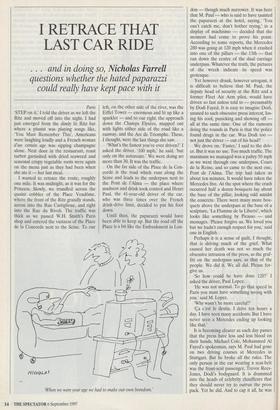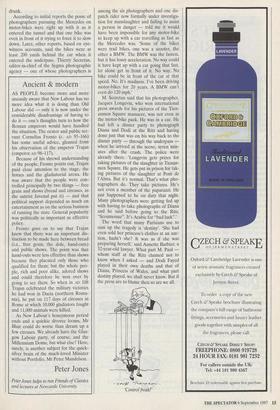I RETRACE THAT LAST CAR RIDE
. . . and in doing so, Nicholas Farrell
questions whether the hated paparazzi could really have kept pace with it
Paris `STEP on it,' I told the driver as we left the Ritz and moved off into the night. I had just emerged from the dimly lit Ritz bar where a pianist was playing songs like, `You Must Remember This', Americans were laughing loudly and a French woman d'un certain age was sipping champagne alone. Next door in the restaurant, roast turbot garnished with dried seaweed and seasonal crispy vegetable roots were again on the menu just as they had been when she ate it — her last meal.
I wanted to retrace the route, roughly one mile. It was midnight, as it was for the Princess. Slowly, we trundled across the quaint cobbles of the Place Vendome, where the front of the Ritz grandly stands, across into the Rue Castiglione, and right into the Rue du Rivoli. The traffic was thick as we passed W.H. Smith's Paris shop and entered the vastness of the Place de la Concorde next to the Seine. To our left, on the other side of the river, was the Eiffel Tower — enormous and lit up like a sparkler — and to our right, the approach down the Champs Elysees, mapped out with lights either side of the road like a runway, and the Arc de Triomphe. These, I thought, were the last things she saw.
`What's the fastest you've ever driven?' I asked the driver. '100 mph,' he said, 'but only on the autoroute.' We were doing no more than 30. It was the traffic.
On the far side of the Place de la Con- corde is the road which runs along the Seine and leads to the underpass next to the Pont de l'Alma — the place where madness and drink took control and Henri Paul, the 41-year-old driver of the car, who was three times over the French drink-drive limit, decided to put his foot down.
Until then, the paparazzi would have been able to keep up. But the road off the Place is a bit like the Embankment in Lon- `When we were your age we had to make our own boredom.' don — though much narrower. It was here that M. Paul — who is said to have taunted the paparazzi at the hotel, saying, 'You can't catch me, don't bother trying,' in a display of machismo — decided that the moment had come to prove his point. According to some reports, the Mercedes 280 was going at 120 mph when it crashed into one of the pillars — the 13th — that run down the centre of the dual carriage underpass. Whatever the truth, the pictures of the wreck indicate its speed was grotesque.
Yet however drunk, however arrogant, it is difficult to believe that M. Paul, the deputy head of security at the Ritz and a former Fleet Air Arm pilot, would have driven so fast unless told to — presumably by Dodi Fayed. It is easy to imagine Dodi, unused to such obsessive press interest, los- ing his cool, panicking and showing off all at the same time. One of the rumours doing the rounds in Paris is that the police found drugs in the car. Was Dodi too not just the driver — out of his head?
We drove on. 'Faster,' I said to the driv- er. But it was no use. Too much traffic. The maximum we managed was a paltry 50 mph as we went through one underpass, Cours de la Reine, and so came to the next one, Pont de l'Alma. The trip had taken us about ten minutes. It would have taken the Mercedes five. At the spot where the crash occurred half a dozen bouquets lay about the base of the pillar, looking odd amidst the concrete. There were many more bou- quets above the underpass at the base of a sculpture, `La Flamme de la Liberte', which looks like something by Picasso — and messages. 'Please forgive us. We loved you but we hadn't enough respect for you,' said one in English.
Perhaps it is a sense of guilt, I thought, that is driving much of the grief. What caused her death was not so much the obsessive intrusion of the press, as the graf- fiti on the underpass says, as that of the people. We did it. We all did. Please for- give us.
`So how could he have done 120?' I asked the driver, Paul Lopez.
`He was not normal. To go that speed in Paris you must have something wrong with you,' said M. Lopez.
`Why wasn't he more careful?'
`ca c'est le destin. I drive ten hours a day. I have seen many accidents. But I have never seen a Mercedes ending up looking like that.'
It is becoming clearer as each day passes that the press have less and less blood on their hands. Michael Cole, Mohammed Al Fayed's spokesman, says M. Paul had gone on two driving courses at Mercedes in Stuttgart. But he broke all the rules. The only person in the car wearing a seat-belt was the front-seat passenger, Trevor Rees- Jones, Dodi's bodyguard. It is drummed into the heads of celebrity chauffeurs that they should never try to outrun the press pack. Yet he did. And to cap it all, he was drunk.
According to initial reports the posse of photographers pursuing the Mercedes on motor-bikes were right up with it as it entered the tunnel and that one bike was even in front of it trying to force it to slow down. Later, other reports, based on eye- witness accounts, said the bikes were at least 200 yards behind the car when it entered the underpass. Thierry Secretan, editor-in-chief of the Sygma photographic agency — one of whose photographers is among the six photographers and one dis- patch rider now formally under investiga- tion for manslaughter and failing to assist a person in danger — told me it would have been impossible for any motor-bike to keep up with a car travelling as fast as the Mercedes was. 'Some of the bikes were trail bikes, one was a scooter, the other a BMW. The BMW was the fastest, but it has lousy acceleration. No way could it have kept up with a car going that fast, let alone get in front of it. No way. No bike could be in front of the car at that speed. No. It's madness. I've been driving motor-bikes for 20 years. A BMW can't even do 120 mph.'
M. Secretan said that his photographer, Jacques Longevin, who won international press awards for his pictures of the Tien- anmen Square massacre, was not even in the motor-bike pack. He was in a car. He had left a dinner party to photograph Diana and Dodi at the Ritz and having done just that was on his way back to the dinner party — through the underpass when he arrived at the scene, seven min- utes after the crash. The police were already there. `Longevin gets prizes for taking pictures of the slaughter in Tienan- men Square. He gets put in prison for tak- ing pictures of the slaughter at Pont de l'Alma. But it's normal. That's what pho- tographers do. They take pictures. He's not even a member of the paparazzi. He just happened to be on duty that night. Many photographers were getting fed up with having to take photographs of Diana and he said before going to the Ritz, "Scoumoune". It's Arabic for "bad luck".'
The word that many Parisians use to sum up the tragedy is 'destiny'. 'She had even sold her princess's clothes at an auc- tion, hadn't she? It was as if she was preparing herself,' said Annette Barbier, a 32-year-old lawyer. What part M. Paul whom staff at the Ritz claimed not to know when I asked — and Dodi Fayed played in their own deaths and that of Diana, Princess of Wales, and what part destiny played, we shall never know. But if the press are to blame then so are we all.
`Control freak!'



























































 Previous page
Previous page